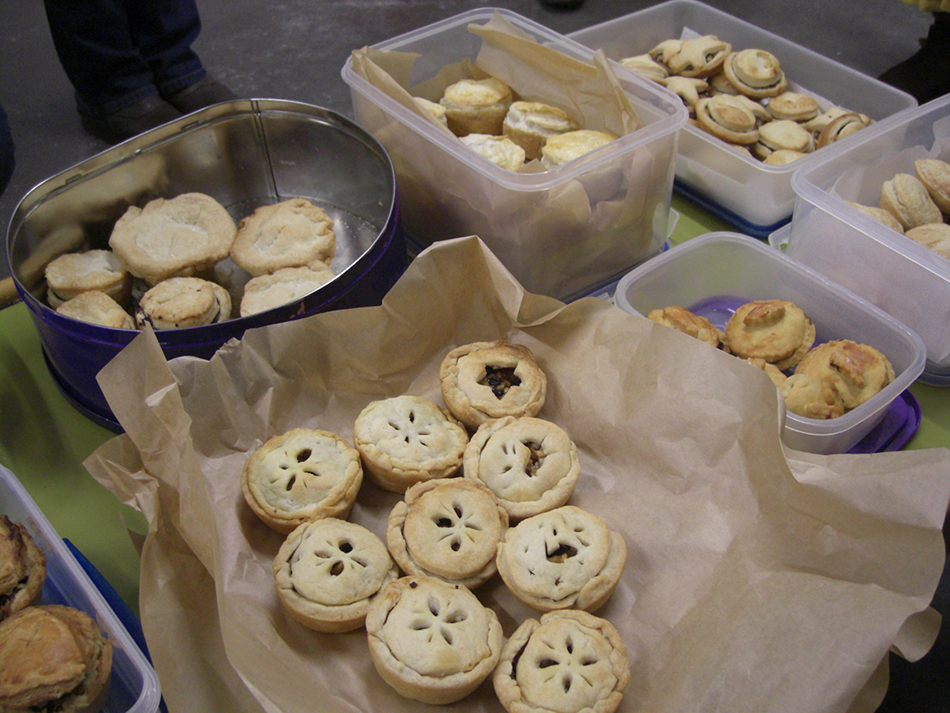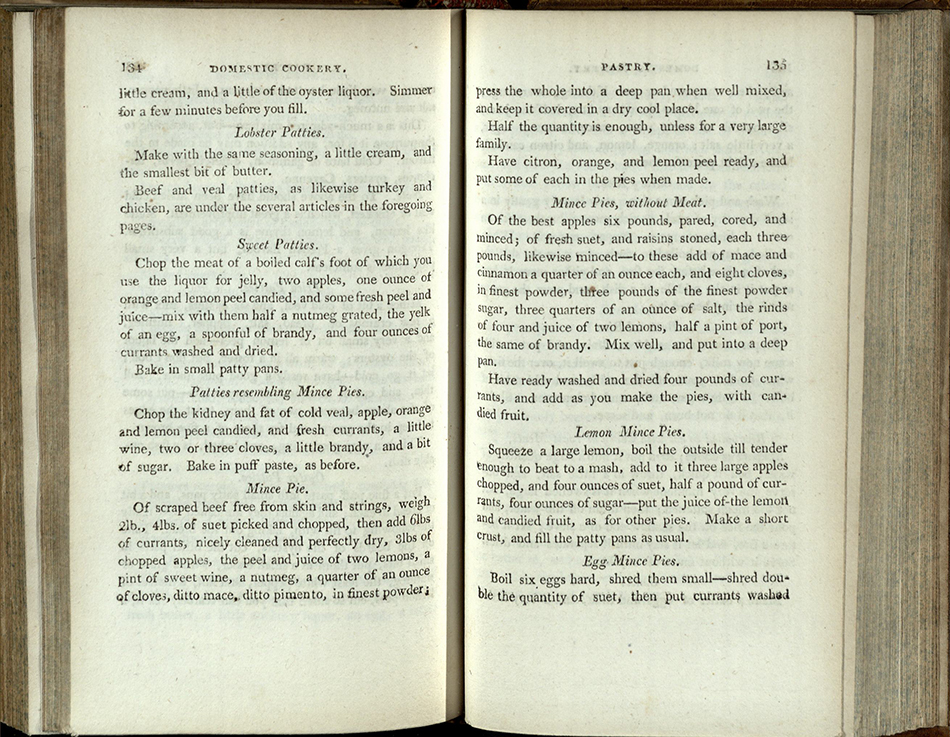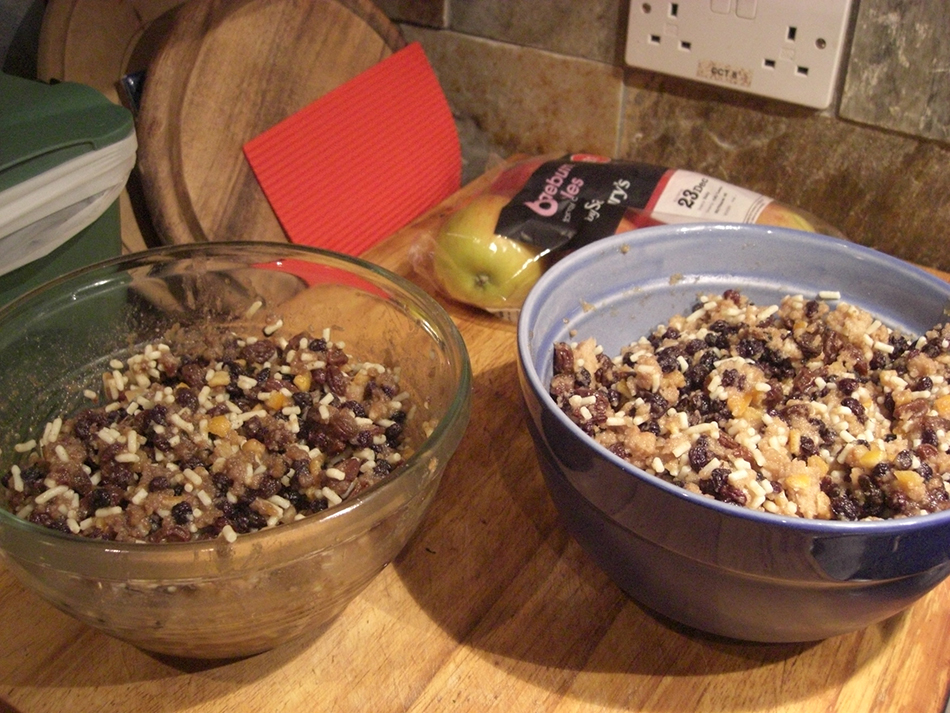52 Weeks of Historical How-To’s, Week 8: The Great Mince Pie Bake Off
When we first started talking about cooking our way through the collections, one of the early ideas was to make mincemeat for Christmas following an historic recipe that contained meat. Once we started looking for mincemeat and mince pie recipes in cookery books and collections of recipes, we were surprised at how many different recipes we found. Meg Dods (a pseudonym of Christian Isobel Johnstone) even began her recipe for ‘Common Mince Pies’ with the comment ‘These are made in an endless variety of ways. Indeed every family receipt book teems with prescriptions. We select what is, after experiment and mature consideration, considered the best formula.’ (The cook and housewife’s manual, 1826. St Andrews copy at s TX717.J6 (SR)).

The idea of experiment and mature consideration to find the best historic mincemeat recipe in our collections was too attractive to ignore, so we launched The Great Mince Pie Bake Off.
In total we found over twenty recipes in the manuscript and rare books collections, ranging in date from c. 1710 to 1862. We then invited staff in the department to choose a recipe to make, and at coffee time on 17 December the table was groaning with ten different types of mince pie.


As it turned out, nine of the recipes we found contained meat, while the others were more familiar combinations of suet, dried fruit, spices and so on. Oddly enough no one signed up to bake the recipe which began ‘Rub with salt and mixed spices a fat bullock’s tongue. Let it lie three days, and parboil, skin, and mince or scrape it’, (Meg Dods’ recipe for ‘Superlative Mince Pies’ in s TX717.J6 (SR)) and no one was adventurous enough to try substituting ‘good tripe’ for beef as a couple of the recipes suggested. Four of the ten recipes cooked for the Bake Off contained meat; interestingly, the presence of meat in the recipes was not a reflection of the date of the recipes, with meat-free recipes from the eighteenth century and meat recipes throughout the nineteenth . Several of the cookery books and recipe compilations contained more than one recipe for mincemeat or mince pies, so the same source might have one recipe with beef and another without.

Historically the meat-free recipes would still not have been suitable for vegetarians as they would have been made with beef suet, but in a shockingly inauthentic twist many of our pies used vegetable suet, enabling the vegetarians in the department to taste at least some of the results.
We were surprised by a couple of popular variations. One was lemon mince pies, made by boiling a squeezed lemon and then beating it to a mash and adding the other ingredients, which appears in both Mrs Edwards manuscript recipe book of c. 1760, and Maria Rundell’s A new system of domestic cookery (London, 1806) St Andrews copy at s TX717.R8. More bizarre-sounding was Egg Mince Pies, which involve mixing finely chopped hard-boiled egg with suet, dried fruit, spices and alcohol. Maria Rundell gives one recipe for this concoction and our earliest manuscript cookery book contains another.

To Season an egg pye
Take and boill 12 eggs and shear ym small wt a pound of beef suet and season it wt Cynnaman, nutmeg and sugar and some Salt and a gill of Cream and 2 or 3 spoon=fulls of seck and some rose water and a pound of Currains and Some Candide or=ange peill and Cittern peill sherd small and half a pound of raisens and mix all together and fill ye pye and when it is baked put in half a pound of butter and ye joice of a Leimond.
– Recipe for an Egg Mince Pie from ms38930

Another surprise was that most of the recipes didn’t specify making the mincemeat some time in advance to let the flavours mature, as modern recipes are likely to do. Only one stated that the mincemeat ‘should be made six weeks before it is wanted’ (John Simpson’s Mince Pies in A complete system of cookery, 1806, St Andrews copy at s TX651.S5) while another advised ‘Though the mince meat will keep good for some time, it is best not to be too old. The fruit, suet, and wine may be added when the pies are to be made, as the suet and raw apples are apt to spoil, and the dried fruits, though in less danger, do not improve by keeping in this state.’ (Meg Dods, The cook and housewife’s manual, 1826, St Andrews copy at s TX717.J6 (SR)). The minced sirloin in John Simpson’s recipe should be well preserved, however, with a whole bottle of brandy and one of sherry poured over it!

In order to judge the bake off, we elected Head of Department Dr Norman Reid to taste all ten types of mince pie without knowing which recipes were which. He was nobly supported in this onerous duty by vegetarian Cecilia for the non-meat recipes and by carnivore Eddie for the meaty ones.

The results were of course interesting. A Scottish recipe from 1862 which contained no alcohol or other liquid and with ginger but no other spices turned out to be more like chopped fruit in a pastry case, rather than what we think of as mincemeat. Maria Rundell’s Mince Pies without Meat was sweeter than modern mincemeat but quite spicy. The Egg Mince Pies had a fudgy consistency and were quite bland but with a strong flavour of cinnamon. But the joint winners of the vegetarian category were both lemon mince pies, described by the judges as tangy and delicious.

A Quick Way to Make Mince Pyes
Four lemons (the juice first squeez’d out) boil’d tender, put into a marble mortar & beat fine. Three quarter of a pound of suet chopt small – 1 pd of sugar, half a pd of currants & spice as you like – one glass of Brandy, & the juice of the Lemons. One pd of raisons stond & chopt & the same of chopt apples.
– from manuscript ms38783

The meat recipes were intriguing because they didn’t taste especially meaty, but the flavours kept changing as you ate the pie. John Simpson’s recipe had a real boozy hit and Meg Dods Common Mince Pies were very spicy, with nutmeg, allspice, cloves and bruised coriander seeds. The favourite recipe in this category was from Agnes McIntosh’s recipe book from 1862.

Mince Pies
1lb Beef
D[itt]o suet
D[itt]o Currants
D[itt]o Raisins
D[itt]o apples
D[itt]o Sugar
¼ lb Lemon peel
1oz Ginger
Mix all together. Take a puff paste, put a layer in the tin, then some of the mixture, then a layer of paste above, pinch around the edges and bake in a moderately hot oven.
– Recipe in ms37114/4
If you would like to take a look at more of the historical recipes Special Collections tried out (and maybe even give them a go yourselves!) then you can find them here: University of St Andrews Mince Pie Cookbook 2013.

Dear Echoes, Just a note to let you know we tweeted this post on the alumni twitter feed! Kurstin [Description: cid:42BF1E92-BAA6-4EF6-8784-84D8832B9FD8] Kurstin Finch Gnehm Development Officer (Annual Giving) Development University of St Andrews Crawford Building 91 North Street St Andrews Fife KY16 9AJ T: +44 1334 461914 M: 07522 089517 E: [email protected] www.st-andrews.ac.uk/develop www.st-andrews.ac.uk/600 Alumni Facebook Page Alumni Twitter Page [Uni-of-year] The University of St Andrews is a charity registered in Scotland, No: SC013532. Gifts to the University of St Andrews American Foundation, a nonprofit 501(c)(3) organization, are tax deductible. The University of St Andrews is committed to sustainable practices and the preservation of the environment - please do not print this email unless absolutely necessary. This message is sent for the addressee only. It may contain legally privileged information. The contents are not to be disclosed to anyone other than the addressee. Unauthorised recipients must preserve this confidentiality and should please advise the sender immediately on receipt of this message. Data Protection Act 1998: All data is securely held in the University of St Andrews Development Office and is treated confidentially and with sensitivity for the benefit of the University and its constituent parts. Full details can be found at: http://www.st-andrews.ac.uk/alumni/relations/Yourdata/ Users of SPARC can view the SPARC Privacy Policy.
thanks Kurstin!
[…] among other items from its archives, historical cookbooks and recreations of their recipes, such as this mincemeat pie bake-off from last […]
[…] flame that was 52 Weeks of Historical How-To’s: a year of exploring our collections, following recipes and knitting patterns, recreating photographic processes, crafting and brewing and climbing […]
[…] week, the Historical How-To’s return for a brief encore. Since the Mince Pie Bake-Off last Christmas was such a success, the staff here at Special Collections decided to celebrate the […]